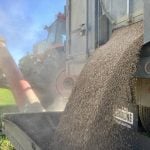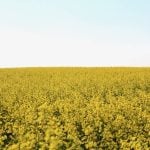
Figure 1
The leaf of giant hogweed is quite large, shown beside a jackknife for reference, and is divided into three broad leaflets that are deeply lobed and toothed.
Photo: OMAFRA
Figure 2
The leaf of Angelica is much smaller, and is comprised of many small leaflets with toothed margins.
Photo: OMAFRA
Figure 3
The flowering heads of giant hogweed are umbrella shaped.
Photo: OMAFRA
Figure 4
The flowering heads of Angelica are completely round or “globe shaped.”
Photo: OMAFRA
Figure 5
The stem of giant hogweed is covered is short whisker-like hairs and is green with purple blotches.
Photo: OMAFRA
Figure 6
The stem of Angelica is completely hairless and takes on more of a reddish/purple colour.
Photo: OMAFRA
Figure 7
Dermatitis caused by making contact with the sap of giant hogweed; the more sap your skin is exposed to, the more severe the injury.
Photo: OMAFRA
Figure 8
An Angelica-based spirit brewed in Ontario.
Photo: Supplied
When plant parts of giant hogweed are torn open, the plant exudes a sap that contains light-activated chemicals known as furanocoumarins.
When these compounds come in contact with the skin, they cause burn-like rashes and/or blisters, the severity of which will depend on how much sap you are exposed to.
There is one very common look-alike species called Angelica, which often gets confused with giant hogweed but is completely harmless and is often used in alcoholic drinks to enhance flavour.
Most of the giant hogweed in Ontario is along water courses, which means you would normally have to go out of your way to come into contact with the plant. But it’s always better to be safe than sorry!
Have a question you want answered? Hashtag #PestPatrol on Twitter to @cowbrough or email Mike at [email protected].





























